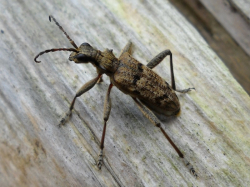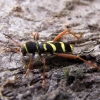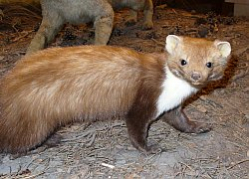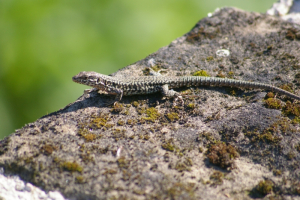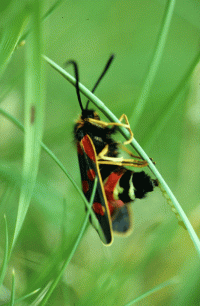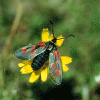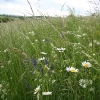Full title: Spatiotemporal changes and current consistency of the Cerambycofauna of Luxembourg for purposes of biodiversity conservation and forestry management.
Abstract
The Cerambycidae is a family of phytophagous Coleoptera widespread in Europe with ~550 species. Their larvae are mostly xylophagous or even saproxylic, acting as primary decomposers of dead or senescent trees. Since some species also have moderate size and pluriannual larval development, Cerambycids are considered high bioindicators of the state of forest health, having become a target group for many research programs in biodiversity and wildlife ecosystems in Europe and abroad. Moreover, several species are protected by Natura-2000 and the law of several European countries. A small number of cerambycids are synanthropic, attacking building woods, sometimes with dramatic consequences. The remaining species are related to living plants, some having great economical importance.
In spite of this, knowledge of the Luxembourgian fauna is still at an early stage not being listed in a local catalogue yet and its biogeographical location being still unknown. The purpose of this project is to improve knowledge on biodiversity, consistency and biogeographical significance of the Luxembourgian cerambycofauna through study of the existing collections, research in the field, comparisons and statistical analyses of data. Species richness will be compared with that of the neighbouring biogeographical regions in order to investigate and understand the faunistic relationships among the different regions of the area around Luxembourg.
The cerambycid biodiversity will be analysed in time and compared with the changes observed over time in climate, vegetation and other groups of insects in order to understand the current quality of environment and individuate the causes of the observed variations. Possible ecological countermeasures will be individuated and proposed. These important environmental topics will be divulgated to the public through the first catalogue on the Cerambycoidea of Luxembourg, including description, colour plates, maps, known biology, importance to forestry, and all faunistic data and salient aspects from a historical-ecological point of view.
Status of PhD
Supervisor at university: Prof. Dr. Thomas Schmitt, Biogeography, Fachbereich VI, Geographie/Geowissenschaften , University Trier.
Supervisor in Luxembourg: Jean-Michel Guinet, Scientifical collections/Entomology, Musée national d’histoire naturelle Luxembourg.
PhD granted by Fonds national de la recherche Luxembourg. Duration: 3 years (01.04.2011-31.03.2014).
Host institution: Fondation faune-flore @ Centre de recherche scientifique, Musée national d’histoire naturelle.
Contact
Francesco Vitali
Musée national d’histoire naturelle
Centre de recherche scientifique
Laboratoire/Section d’Entomologie
24, rue Münster
L-2160 Luxembourg
phone: (+352) 46 22 40 -206
fax: (+352) 463 848
Publications and not published works
- Vitali, F., 1991. Segnalazioni faunistiche italiane, 190. Bollettino della Società entomologica italiana, 123 (1): 74.
- Vitali, F., 1995. Segnalazioni faunistiche italiane, 283-287. Bollettino della Società entomologica italiana, 127 (1): 68-69.
- Vitali, F., 1996. Segnalazioni faunistiche italiane, 309-312. Bollettino della Società entomologica italiana, 128 (1): 90.
- Vitali, F., 1998a. Nouvelle découverte de Phorachanta semipunctata (Fabricius) (Col. Cerambycidae). L’Entomologiste, 54 (6): 250.
- Vitali, F., 1998b. La figura del naturalista nell’indagine ricognitiva. Presenza tecnica, XXVI (2): 78.
- Vitali, F., 1999a. Il pericolo termiti per la cattedrale di Genova. Presenza tecnica, XXVII (2): 54-55.
- Vitali, F., 1999a. Nuovi dati corologici per alcune specie di Cerambicidi italiani (Coleoptera Cerambycidae). Doriana, VII (315): 1-6.
- Vitali, F., 1999b. Eine neue Trirachys-Art von den Philippinen (Coleoptera, Cerambycidae, Cerambycinae). Mitteilungen der Münchner entomologischen Gesellschaft, 89: 71-73.
- Vitali, F., 2000. Eine neue Cylindrepomus-Art von Malakka (Coleoptera, Cerambycidae). Entomofauna, 21 (21): 253-256.
- Vitali, F., 2001a. Description des œufs des espèces françaises du genre Cerambyx. (première contribution à l’étude des œufs des longicornes) (Coleoptera, Cerambycidae, Cerambycinae). Les Cahiers Magellanes, 4: 1-14.
- Vitali, F., 2001b. Vesperus ligusticus, nuova specie di cerambicide italiano (Coleoptera, Cerambycidae, Vesperinae). Lambillionea, CI (1): 149-152.
- Vitali, F., 2001c. Description de la larve de deux longicornes de Guadeloupe: Chaetanes fleutiauxi Villiers, 1980 et Leptostyloides assimilis (Gahan, 1895) (Coleoptera, Cerambycidae, Lamiinae, Acanthocinini). L’Entomologiste, 57 (3-4): 151-156.
- Vitali, F., 2002a. Versetzung der Tribus Holopterini Lacordaire, 1869 zur Unterfamilie Lepturinae (Coleoptera, Cerambycidae). Entomofauna, 23 (3): 29-33.
- Vitali, F., 2002b. Acrepidopterum reseri nov. sp., a new Jamaican longicorn beetle (Coleoptera, Cerambycidae, Lamiinae, Ptericoptini) – Spixiana, 25 (2): 137-139.Vitali
- Vitali, F., 2002c. Segnalazioni faunistiche italiane, 407. Bollettino della Società entomologica italiana, 133 (3): 272.
- Vitali, F. & L., Rezbanyai-Reser, 2003a. Beiträge zur Insektenfauna von Jamaika, Westindien (Karibik). 5. Bockkäfer, Teil I (Coleoptera Cerambycidae). Les Cahiers Magellanes, 26: 1-16.
- Vitali, F. & L., Rezbanyai-Reser, 2003b. Beiträge zur Insektenfauna von Jamaika, Westindien (Karibik). 5. Bockkäfer, Teil II (Folge)(Coleoptera Cerambycidae). Les Cahiers Magellanes, 27: 1-27.
- Vitali, F., 2004a. Pseudosieversia europaea new species from Baltic amber (Coleoptera, Cerambycidae, Lepturinae). Les Cahiers Magellanes, 35: 1 -8.
- Vitali, F., 2004b. Plectromerus tertiarius new fossil species from Hispaniola (Coleoptera, Cerambycidae, Cerambycinae). Lambillionea, CIV (3): 453-458.
- Vitali, F., 2004c. Palaeological consideration about a Paracorymbia hybrida (Rey, 1885) relict station (Coleoptera, Cerambycidae, Lepturinae). Biocosme Mesogéen, 20 (3-4): 137-144.
- Vitali, F., 2004d. Xylotrechus smei (Castelnau & Gory, 1841), its presence in Palaearctic region and description of the pupa (Coleoptera, Cerambycidae). Doriana, VII (340): 1-7.
- Vitali, F., 2005a. Vesperus strepens m. litigiosus Mulsant, 1862 new species for Italy (Coleoptera, Cerambycidae, Vesperinae). Lambillionea CV (2): 331-334.
- Vitali, F., 2005b. Notes about European fossil Lepturinae and the description of a new species (Coleoptera, Cerambycidae, Lepturinae). Lambillionea CV (4): 530-538.
- Vitali, F. & J., Touroult, 2005. Contribution à la connaisance des larves des longicornes des Antilles françaises (Coleoptera Cerambycidae). L’Entomologiste, 61 (2): 64-81.
- Vitali, F., 2006a. About Aenictosoma doenitzi Schaufuss, 1891 (Coleoptera, Cerambycidae, Scydmaenidae). Spixiana 29 (2): 99-101.
- Vitali, F., 2006b. A new cerambycid from Dominican amber and remarks on the fossil Plectromerus-species (Coleoptera, Cerambycidae). Entomapeiron (P. S.) 1 (1): 1-12.
- Vitali, F., 2006c. About two Batrachorhina-species included in Malagasy copal (Coleoptera, Cerambycidae). Entomapeiron (P. S.) 1(2): 13-20.
- Vitali, F., 2006d. The real taxonomic position of Spondylis florissantensis Wickham, 1920 (Coleoptera, Cerambycidae). Entomapeiron (P. S.) 1(2): 21-27.
- Vitali, F., 2006e. Contribution à la connaissance des Nethinius malgaches (Coleoptera, Disteniidae). L’Entomologiste 62 (5-6) ): 175-178.
- Vitali, F., 2006f. Taxonomic, biological and evolutionistic notes on the Spondylidinae included in Baltic amber (Coleoptera, Cerambycidae). Entomapeiron (P. S.) 1 (3): 29-44.
- Vitali, F. & J., Touroult, 2006a. Contribution à la connaissance des états pré-imaginaux des longicornes de Guadeloupe (Coleoptera Cerambycidae). L’Entomologiste 62 (1-2): 3-6.
- Vitali, F. & J., Touroult, 2006b. Contribution à la connaissance des états pré-imaginaux des longicornes des Canaries (Coleoptera, Cerambycidae, Lamiinae). Lambillionea CVI (2): 193-201.
- Vitali, F., Wolf, K. W. & J., Haxaire, (2006). Biological and faunistic notes on the Jamaican population of Steirastoma histrionicum White, 1855 (Coleoptera, Cerambycidae). Lambillionea CVI (4): 661-667.
- Vitali, F., 2007a. A new species of Corticeus Piller & Mitterpacher, 1783 from Dominican amber (Coleoptera Tenebrionidae). Entomapeiron (P. S.) 2 (1): 1-6.
- Vitali, F., 2007b. About some sub-fossil Glaucytini included in Malagasy copal (Coleoptera, Cerambycidae). Entomapeiron (P. S.) 2 (1): 7-13.
- Vitali, F., 2007c. Short Notes I: Observations about another specimen of Pseudosieversia europaea Vitali, 2004 (Coleoptera Cerambycidae). Entomapeiron (P. S.) 2 (1): 14.
- Vitali, F., 2007d. Short Notes II: About the identity of Dorcadionoides subaeneus Motschulsky, 1857 (Coleoptera Cerambycidae). Entomapeiron (P. S.) 2 (1): 15-16.
- Vitali, F., 2007e. Anomalies multiples chez un exemplaire tératologique d’Acanthinodera cumingii (Hope, 1833) (Coleoptera Cerambycidae). L’Entomologiste 63 (2): 87-88.
- Vitali, F., 2007f. Notes and taxonomic corrections to the Beiträge von Insektenfauna von Jamaika, Cerambycidae (Coleoptera Cerambycidae) -Entomapeiron (N. S.) 1 (2): 37-59.
- Vitali, F., 2007g. A new fossil species of Elaphidion Audinet-Serville, 1834 with systematic notes on the Lamiinae from Dominican amber (Coleoptera Cerambycidae). Entomapeiron (P. S.) 2 (3): 29-39.
- Vitali, F., 2007h. Short notes III: The taxonomic position of Haplocnemia sophiae Statz, 1938 (Coleoptera Cerambycidae). Entomapeiron (P. S.) 2 (3): 40.
- Vitali, F., 2007i. About the taxonomic status of some species of the genus Aeolesthes Gahan, 1890 (Coleoptera Cerambycidae). Entomapeiron (N. S.) 1 (3): 65-80.
- Vitali, F., & Casadio, C. A., 2007. Contribution to the Cerambycid Fauna of the Solomon Islands (Coleoptera Cerambycidae). Entomapeiron (N. S.) 1 (1): 1-36.
- Vitali, F. & J., Haxaire, 2007. A new species of Plectromerus Haldeman from Jamaica (West-Indies) (Coleoptera Cerambycidae). Entomapeiron (N. S.) 1 (2): 60-64.
- Bellés, X. & F., Vitali, 2007. New fossil spider beetles from Baltic amber (Coleoptera Ptinidae). Entomapeiron (P. S.) 2 (2): 17-28.
- Vitali, F., 2008a. Systematic revision of the fossil cerambycids from Geiseltal (Coleoptera Cerambycidae). Entomapeiron (P. S.) 3 (1): 1-10.
- Vitali, F., 2008b. A new species of Tyrtaeus Champion, 1913 from Dominican amber (Coleoptera Tenebrionidae). Entomapeiron (P. S.) 3 (1): 11-15.
- Vitali, F., 2008c. Taxonomic and faunistic notes about the genus Olethrius Thomson, 1860 (Coleoptera Cerambycidae). Entomapeiron (N. S.) 2 (1): 1-32.
- Vitali, F., 2009a. Two new longhorned beetles from Dominican amber (Coleoptera, Cerambycidae). Denisia 69: 223-230.
- Vitali, F., 2009b. The cerambycids included in Baltic amber: current knowledge status with the description of new taxa (Coleoptera, Cerambycidae). Denisia 69: 231-242.
- Vitali, F., 2009c. About some interesting fossil and sub-fossil Cerambycids of the collection Velten (Coleoptera, Cerambycidae) – Lambillionea CIX (3): 352-357.
- Vitali, F. & Nagirnyi, V., 2009. Nemophas ramosi Schultze, 1920, a forgotten Philippine species (Coleoptera, Cerambycidae). Lambillionea CIX (4): 470-475.
- Vitali, F., 2010a. Diplocoelus probiphyllus n. sp., the first known fossil False Skin Beetle (Coleoptera: Biphyllidae). Annales de la Société entomologique de France 46 (1/2): 168-172
- Vitali, F., 2010b. Taxonomic and synonymic notes about some Indonesian species of the genus Acalolepta Pascoe, 1858 (Coleoptera: Cerambycidae, Lamiini). Suara Serangga Papua 4 (4): 94-98.
- Vitali, F., 2010c. Taxonomic and Faunistic notes about some Asian cerambycids belonging to the national museum of natural history of Luxembourg (Coleoptera, Cerambycidae). Lambillionea CX (2): 179-184.
- Vitali, F., 2010d. Catalogue of the types of the Cerambycoidea of the National Museum of Natural History of Luxembourg. Annales de la Societé entomologique de Belgique 80: 109-126.
- Vitali, F., 2010e. A new fossil species of the genus Stizocera Audinet-Serville, 1834 from Dominican amber (Coleoptera, Cerambycidae). Lambillionea CX (3): 340-343.
- Haller, P. & Vitali, F., 2010. Une nouvelle espèce de Pachydissus Newman, 1838 (Coleoptera, Cerambycidae). Lambillionea CX (2) : 263-266.
- Vitali, F. & H., Menufandu, 2010. A new species of Protilema Aurivillius, 1908 (Coleoptera: Cerambycidae, Morimopsini) from Waigeo Island, New Guinea. Suara Serangga Papua 4 (4): 89-93.
- Vitali, F., 2011a. Six new fossil Cerambycids included in Baltic and Saxon amber (Coleoptera Cerambycidae). Entomapeiron (P. S.) 4 (1): 1-34.
- Vitali, F., 2011b. Short Notes IV. Saperdopsis robusta Schmidt, 1967: an extant Chinese species? (Coleoptera Cerambycidae). Entomapeiron (P. S.) 4 (1): 35-36.
- Vitali, F., 2011c. Un nouveau Callichromatini de la République démocratique du Congo (Coleoptera Cerambycidae Cerambycinae). L’Entomologiste 67 (2): 91–93.
- Vitali, F., 2011d. Systematic, taxonomic and faunistic notes about some African cerambycids belonging to the National Museum of Natural History of Luxembourg (Coleoptera, Cerambycidæ). Entomologia Africana 16 (1): 2-12.
- Vitali, F., 2011e. Une nouvelle espèce d’Acanthocinus du Portugal (Coleoptera, Cerambycidae). Lambillionea CXI (2): 161-164.
- Vitali, F., 2011f. Notes on the genus Acalolepta Pascoe, 1858 (Coleoptera: Cerambycidae) from Indonesian Papua and the Moluccas. Wallacea 1: 291-297 + Pl. 40-43.
- Vitali, F., 2011g. Observations faunistiques sur les Cérambycidés luxembourgeois conservés dans la collection du Musée national d’histoire naturelle de Luxembourg (Coleoptera, Cerambycidae). Lambillionea CXI (3): 278-284.
- Casadio, C. A. & F., Vitali, 2011. Faunistic notes about an entomological survey to Kepulauan Biak, Papua (Coleoptera: Cerambycidae). Suara Serangga Papua 5 (3): 92-98.
- Juhel P. & Vitali, F., 2011. Contribution à l’étude des Callichromatini Africains (5e Note): les types de Hintz. (Coleoptera, Cerambycidae, Cerambycinae). Les Cahiers Magellanes N.S. 4 (1): 1-22.
- Vitali, C. & F., Vitali, 2011. Révision du sous-genre Ochropyga Aurivillius, 1913 (Coleoptera, Cerambycidae, Lamiinae, Prosopocerini). Les Cahiers Magellanes N.S. 4 (1): 23-30.
- Vitali, F., Drumont, A. & J. L., Renneson, 2012. Note sur la distribution de Protaetia (Liocola) marmorata (Fabricius, 1792) au Grand-duché de Luxembourg (Coleoptera, Scarabaeidae, Cetoniinae). Cetonimania N.S. 3: 14-19.
- Vitali, F., 2012a. Les espèces de Meloe L., 1758 au Grand-Duché de Luxembourg (Coleoptera, Meloidae). L’Entomologiste 68 (1): 49–52.
- Vitali, F., 2012b. Nouvelles données faunistiques sur les Longicornes du Grand-Duché de Luxembourg (Coleoptera, Cerambycidae). Lambillionea CXII (3): 235-240.
- Perger, R. & F., Vitali, 2012. Revision of the genus Megacriodes Pascoe, 1866, a new synonym of Batocera Laporte de Castelnau, 1840 (Coleoptera, Cerambycidae, Lamiinae). Les Cahiers Magellanes N.S. 7: 1-17.
- Vitali, F., Drumont, A. & J. L., Renneson, 2012. Note sur la distribution de Protaetia (Liocola) marmorata (Fabricius, 1792) au Grand-duché de Luxembourg (Coleoptera, Scarabaeidae, Cetoniinae). Cetonimania N.S. 3: 14-19.
- Vitali, F. & C., Vitali, 2012. Notes faunistiques et taxonomiques concernant quelques espèces de Lamiaires Africains (Coleoptera, Cerambycidae). Lambillionea CXII (1): 7-10.
Talks and poster presentations
- Vitali, F., 1992. The family Cerambycidae. Genoa University, Department of Zoology, Genoa, Italy 05/92.
- Vitali, F., 1998. The ultrasounds employment in the research about the materials: the wood decay. Polytechnic, Faculty of Architecture, Turin, Italy, 11/05/98.
- Vitali, F., 1999. The analysis of the wood and the concrete decay. Polytechnic, Faculty of Architecture, Turin, Italy, 11/05/99.
- Vitali, F., 2007a. Between earth and sea, biodiversity in the Cinque Terre National Park. Insects: a park in miniature to be defended and discovered. Conference hall of Torre Guardiola, Riomaggiore, La Spezia, Italy, 11/05/07.
- Vitali, F., 2007b. Between earth and sea, biodiversity in the Cinque Terre National Park. Insects: a park in miniature to be defended and discovered. Municipality of Monterosso al Mare, La Spezia, Italy, 12/05/07.
- Vitali, F., 2012a. Longicornes du Luxembourg et changement climatique. Réunion des collaborateurs scientifiques, Centre culturel de rencontre Abbaye Neumünster, Luxembourg, 17/03/12.
- Vitali, F., 2012b. Longicornes du Luxembourg et changement climatique. Société Lorraine d’Entomologie, MJC Bazin, Nancy, France, 15/05/12.
